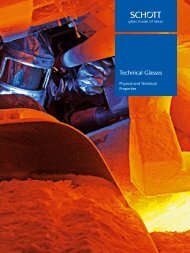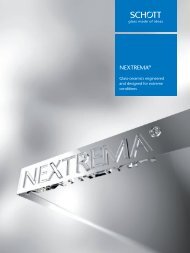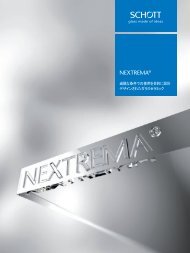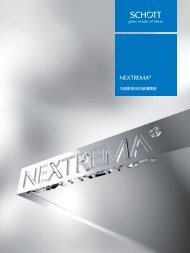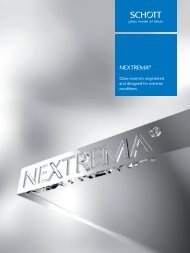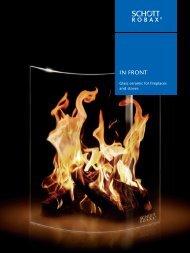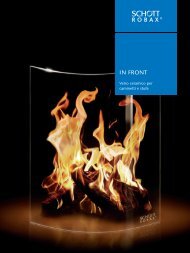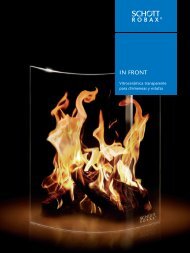Technology Magazine "SCHOTT solutions" Edition 2/2014
The SCHOTT solutions glass magazine features articles, reports and interviews on glass technological challenges from all over the world. The SCHOTT Technology Magazine. Beiträge, Reportagen und Interviews zu Lösungen von SCHOTT für technologische Herausforderungen weltweit.
The SCHOTT solutions glass magazine features articles, reports and interviews on glass technological challenges from all over the world.
The SCHOTT Technology Magazine. Beiträge, Reportagen und Interviews zu Lösungen von SCHOTT für technologische Herausforderungen weltweit.
Create successful ePaper yourself
Turn your PDF publications into a flip-book with our unique Google optimized e-Paper software.
WASHING THE AIR<br />
WASCHGANG FÜR DIE LUFT<br />
The Bavarian company Triplan Umwelttechnik is bringing fresh air to old buildings with<br />
an innovative idea: its engineers use UV light to banish moldy, musty smells from rooms.<br />
Special glass from schott Tubing helps remove the unwanted odors.<br />
Mit einer innovativen Idee bringt das bayerische Unternehmen Triplan Umwelttechnik frische<br />
Luft in alte Gebäude: Mittels UV-Licht säubern die Harburger Ingenieure Räume von muffi g-<br />
modrigen Gerüchen. Doch erst Spezialglas von schott sorgt für die optimale Beseitigung<br />
von unerwünschten Düften.<br />
SEBASTIAN KIRSCHNER<br />
C<br />
orked wine and musty rooms: both are unpleasant – and both<br />
often have the same cause. The wood preservatives used in<br />
impregnated pallets and the wooden beams of old houses over decades<br />
release gases that cause moldy smelling aerosols to appear,<br />
the same molecules that accumulate on corks and give a once<br />
delicious wine that feared corked taste. Help comes in the form of<br />
photocatalysis – a process that decomposes the undesirable gases<br />
using a catalyst and UV radiation. But existing solutions have their<br />
drawbacks: “The present technology is neither very efficient nor<br />
particularly sustainable,” explains Andreas Beck, Managing Director<br />
of Triplan Umwelttechnik.<br />
But now, Beck and his team of engineers have developed the<br />
triplan LightClean® ventilation solution. It uses glass instead of<br />
paper as the carrier for the catalyst. The device, a simple, stainless<br />
steel column with a built-in ventilator, first sucks up the polluted<br />
air in the room. “The contaminant molecules accumulate inside<br />
triplan LightClean® on a panel consisting of small glass tubes measuring<br />
about six inches in length,” says Beck. The individual glass<br />
tubes are coated with a semiconductor material using a specially<br />
developed process. When stimulated by UV light, cold combustion<br />
converts the contaminants into carbon dioxide and water. triplan<br />
LightClean® then releases the cleansed air back into the room.<br />
To achieve this innovation, the Harburg-based company employs<br />
duran® borosilicate glass tubing from schott. This special<br />
purpose glass offers key advantages that make it an ideal catalyst<br />
carrier: “It has a much higher level of efficiency than any other material,”<br />
says Beck. “Because of the high transparency of the duran®<br />
glass tubing, the UV light can penetrate deep into the reactor and<br />
reaches a much larger activation surface using the same amount<br />
of energy,“ explains Dietmar Katlun, Area Sales Manager at schott<br />
Technical Tubing. This also makes triplan LightClean® highly<br />
K<br />
orkender Wein oder muffige Räume: Beides ist unangenehm<br />
– und beides hat häufig die gleiche Ursache. Imprägnierte<br />
Paletten und Gebälk alter Häuser gasen über Jahrzehnte<br />
Fragmente ihrer Holzschutzmittel aus. Dabei entstehen modrig<br />
riechende Aerosole, dieselben Moleküle, die sich an Korken anlagern<br />
und aus köstlichem Wein den gefürchteten „Korkschmecker“<br />
machen. Abhilfe schafft hierbei die sogenannte Photokatalyse – eine<br />
Technik, die mit Katalysator und UV-Strahlung die ungeliebten<br />
Gase zersetzt. Doch bisherige Lösungen haben Nachteile: „Die Geräte<br />
haben weder einen guten Wirkungsgrad noch sind sie besonders<br />
nachhaltig“, erklärt Andreas Beck, Geschäftsführer der Firma<br />
Triplan Umwelttechnik. Beck hat deshalb mit seinem Team die Lüftungslösung<br />
triplan LightClean® entwickelt. Das Besondere dabei:<br />
duran® tubes are an ideal substrate for the catalytic semiconductor<br />
material. In addition, they are also very durable.<br />
duran® Röhren sind ein ideales Trägermaterial für das katalytische<br />
Halbleitermaterial. Außerdem sind sie besonders lange haltbar.<br />
49






